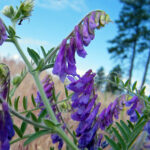Hairy Vetch
Vicia villosa ssp villosa
General Description
Hairy vetch is an annual or biennial, hardy, cool season agronomic legume, also commonly referred to as fodder vetch, winter vetch, or sand vetch. It has a weak tap root that grows up to 60 to 90 cm (24 to 35 in) with many side branches in the top 20 cm (8 in) and is known as an excellent nitrogen fixer.
Type
Tame legume.
Origin
Native to Europe and Asia. Now the most used vetch in North America.
Longevity
Annual or biennial.
Use
Hay, grazing, erosion control. Consumption of seed can be poisonous to livestock. Hairy vetch is especially known for erosion control, bank stabilization, winter cover crop, and soil conditioning. It can be a suitable plant in organic and no-till pasture and cropping systems.
Optimal Time of Use
Spring and winter.
Recovery After Use
The growth habit of hairy vetch means it is typically used once per grazing season.
Hay yield of 1.5 to 3.5 tons of dry matter per acre have been reported.
Palatability/Nutritional Value
High palatability, high crude protein values and very digestible.
Annual Precipitation min/max (mm)
450mm / 600mm.
Drought Tolerance
High drought tolerance.
Flooding Tolerance
Some flooding tolerance but not adapted to poorly drained soils.
Winter Hardiness
Winter hardy but dependent on good snow cover. Vetch seeded alone may be vulnerable to frost heave damage.
Soil Texture Preference
Prefers sandy soils but is adapted to all soil textures.
Erosion Control
High ability to control erosion. Hairy vetch can provide a heavy surface mulch.
Salinity Tolerance
Low to moderate tolerance.
Acidity Tolerance
Low tolerance, prefers pH 6.0 to 7.5.
Alkalinity Tolerance
Low tolerance.
Seeds per kg
44,000 seeds/kg (97,003 seeds/lb).
Suggested Mixtures
Hairy vetch is commonly fall-seeded with rye for pasture use.
Ease of Establishment
Easily establishes where adapted.
Competitiveness
Once established, hairy vetch can be aggressive and competitive. It sets seed and can proliferate from self-seeding.
Management Considerations
Hairy vetch is normally planted in the fall. It can be broadcast or drill seeded.
BC Rangeland Seeding Manual, USDA Plants Database
Hairy vetch is adapted to the Sub-Boreal Spruce, Sub-Boreal Pine-Spruce and Interior Cedar-Hemlock zones. In the southern part of the Central Interior it is adapted to wetter parts of the Interior Douglas-fir zone, and to irrigated and subirrigated areas in the Bunchgrass zone and dry parts of the Interior Douglas-fir zone.
Hairy vetch is adapted to wetter areas in the region (i.e., the Interior Cedar-Hemlock zone and wetter parts of the Interior Douglas-fir zone), and to irrigated or subirrigated areas in the Bunchgrass, Ponderosa Pine and Interior Douglas-fir zones.
